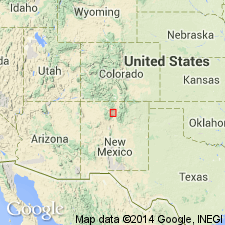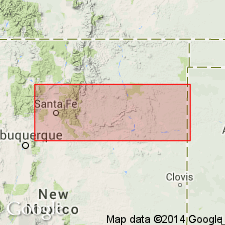
- Usage in publication:
-
- Santa Clara basalt
- Modifications:
-
- Original reference
- Dominant lithology:
-
- Basalt
- AAPG geologic province:
-
- San Juan basin
Summary:
Santa Clara basalt. Named as seventh (and youngest) in a series of Quaternary formations in area. Santa Clara basalt and Bandelier rhyolite (new) tuff locally overlie Puye formation (new).
Occurs in Abiquiu quadrangle, Rio Arriba Co., north-central NM.
Source: GNU records (USGS DDS-6; Denver GNULEX).

- Usage in publication:
-
- Santa Clara Pumice Bed
- Modifications:
-
- Revised
- AAPG geologic province:
-
- San Juan basin
Summary:
Santa Clara Pumice Bed of Bandelier Rhyolite of Tewa Group. Occurs at base of "middle" member of Bandelier Rhyolite, locally in Jemez Mountains, Bandelier National Park, Los Alamos County, New Mexico. Consists of pumice and pumice gravel. Thickness up to 100 feet. Is an apron of explosive rhyolite debris which nearly surrounds the eroded older "Chicoma" volcanics. Age is Pleistocene.
[GNU remark (USGS DDS-6; Denver GNULEX, June 1, 1987): Santa Clara Pumice Bed probably not a good unit. Not used by anyone else.]
Source: Modified from GNU records (USGS DDS-6; Denver GNULEX).
For more information, please contact Nancy Stamm, Geologic Names Committee Secretary.
Asterisk (*) indicates published by U.S. Geological Survey authors.
"No current usage" (†) implies that a name has been abandoned or has fallen into disuse. Former usage and, if known, replacement name given in parentheses ( ).
Slash (/) indicates name conflicts with nomenclatural guidelines (CSN, 1933; ACSN, 1961, 1970; NACSN, 1983, 2005, 2021). May be explained within brackets ([ ]).

